The MacBook Pro Review (13 & 15-inch): 2011 Brings Sandy Bridge
by Anand Lal Shimpi, Brian Klug & Vivek Gowri on March 10, 2011 4:17 PM EST- Posted in
- Laptops
- Mac
- Apple
- Intel
- MacBook Pro
- Sandy Bridge
Improved WiFi Performance
One of the more notable changes in the 2011 MacBook Pro lineup is a completely different WiFi chipset and subsequent RF design. The previous 2010 MacBook Pro included 802.11a/b/g/n support using a BCM4322 which included full 2x2 MIMO support, meaning two spatial streams were supported. Bluetooth 3.0 was provided by a BCM2070, and the whole solution was simply a BCM954224HMB reference design.

2011 MacBook Pro WiFi+BT Module—Courtesy iFixit
Back when the new Airport Extreme (Simultaneous Dual-Band II) launched, it included one little-hyped feature. One of the most notable improvements over the previous design was inclusion of a full 3x3 radio—again 3 spatial stream support. At the time, there were no Apple products that could actually use 3 spatial streams, and as a result many assumed the feature was completely locked down.
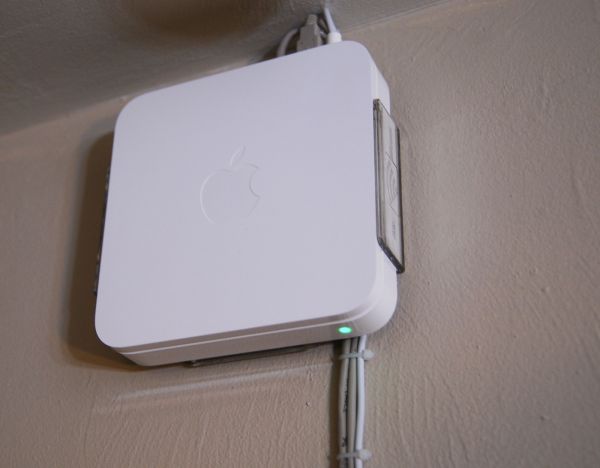
My wall-mounted Airport Extreme (Simultaneous Dual-Band II)
The Airport Extreme has had 3 spatial stream support for a long time to little fanfare. The Airport Extreme still only allows 20 MHz channels on 2.4 GHz spectrum. Other WiFi AP vendors ship firmware which will automaticaly selects 40 MHz channels on 2.4 GHz spectrum per WiFi Alliance rules, but Apple uniformly uses 20 MHz channels on 2.4 GHz. It's a design choice Apple made a while ago which still exists to this day – for two reasons. The first is that it prevents you from being, well, less than courteous and eating up to over 80% of spectrum on the already crowded 2.4 GHz ISM band with one AP. Apple's rationale for disabling 40 MHz channel support on the 2.4 GHz spectrum (for both clients and APs) is that Bluetooth needs lots of bandwidth to hop around on, and already a wide variety of Apple desktop and notebook products come by default with Bluetooth peripherals. Maintaining a good A2DP stereo stream for example requires considerable 2.4 GHz bandwidth. Instead, if you really want 40 MHz channels Apple recommends using 5 GHz, which Apple clients and Apple APs both allow to work with 40 MHz channels.
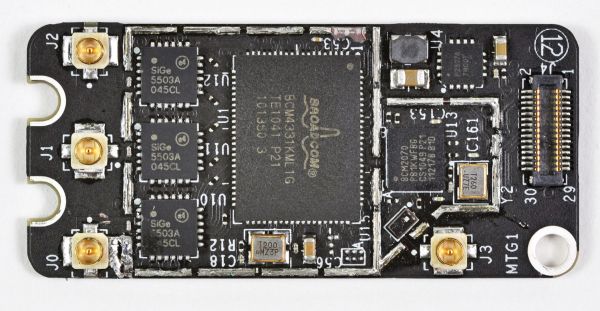
2011 MacBook Pro WiFi+BT Module—Courtesy iFixit
The 2011 MacBook Pro refresh is the first line of Apple products to bring 3x3 radios that can finally enable faster transfer rates and better performance at the edge of WiFi range. 3x3 MIMO support is starting to become relatively common in the PC notebook space, but this is the first for Apple. Inside the 2011 MacBook Pro is a BCM4331 and three clearly U.FL antenna connectors (on the left) for WiFi, as opposed to two in the previous design.
The fourth on the right is for Bluetooth, which remains 3.0 and provided by the same BCM2070 as previous models. Interestingly enough, though the Bluetooth controller is the same, the 2011 MacBook Pro includes newer firmware (37 vs 20), and software (2.4.3f1 vs 2.3.8f7). Hopefully at some point the older design will see a firmware update and bring whatever changes and improvements were made. Though the software versions are different, we couldn't detect any notable differences between the two in practice.

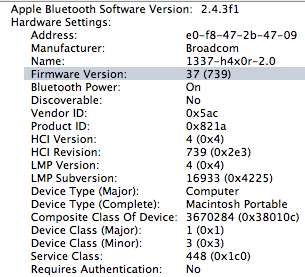
Left: 2010 MBP Bluetooth Hardware, Right: 2011 MBP Bluetooth
However, there's a dramatic improvement in both WiFi range and performance between the 2010 and 2011 refresh. With 400 ns guard intervals 40 MHz channels, 64-QAM modulation, each spatial stream adds n*150 Mbps. With 20 MHz channels, it's 72.2*n Mbps. For example, 1 spatial stream has a data rate of 150 Mbps, 2 has 300 Mbps, 3 has 450 Mbps, and so forth all the way up to 4 spatial streams and 600 Mbps as defined in the 802.11n specification. The reality of the matter is that what physical layer rate you'll see depends on the modulation and coding scheme and how many streams are going. You can look those up at any time by holding option and clicking the WiFi indicator, and looking them up in a table.
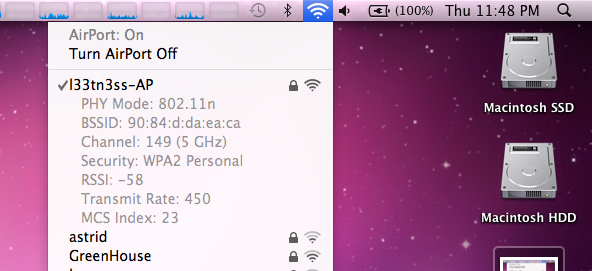
We tested a 15" 2011 MacBook Pro alongside a 15" 2010 MacBook pro connected to an Airport Extreme (Simultaneous Dual-Band II) running latest firmware. I originally suspected that 3 spatial stream support wasn't enabled, and that Apple would push a firmware update out right after their first 3 spatial stream products started shipping. Interestingly enough, it's always been there, enabled, this is just the first client I've gotten my hands on that does it. I'm not a huge fan of the Airport Extreme (I use a WRT54G-TM with Tomato and a WRT-600N with DD-WRT), but it's the only thing on hand with 3x3 MIMO. I tested in four different locations in my house—in my office, living room, kitchen, and outdoor patio. The base station is in my office mounted on the wall close to the ceiling, and those locations are subjectively ordered from best to worst.
To test, I initiated a large transfer over SMB (from a Windows Server 2008 R2 install with a 5 TB RAID5 array connected over gigabit ethernet) on each client, continually pinged AT, and at each location checked the reported transmit rate and RSSI. What we're reporting here is again the physical layer link. I'll show in a second that real-world transfers also improved, this just gives some perspective for what raw link rates are being negotiated at each location.
| WiFi Transfer Rate Differences—802.11n | ||||||||
| 2011 MacBook Pro | 2010 MacBook Pro | |||||||
| RSSI | Transfer Rate (Mbps) | RSSI | Transfer Rate (Mbps) | |||||
| Location 1—Office | -44 | 450 | -42 | 300 | ||||
| Location 2—Living Room | -61 | 130 | -64 | 117 | ||||
| Location 3—Kitchen | -69 | 117 | -68 | 78 | ||||
| Location 4—Outdoor Patio | -85 | 20 | -84 | 13 | ||||
In most cases, RSSI is within the margin of error. RSSI is generally not something you can compare, but since both wireless chipsets are Broadcom and the numbers are so close, it seems they're reported the same way and probably just dBm. Just know that generally it doesn't work that way unless you're lucky. What's important, however is that the negotiated link speed is noticeably better in essentially all locations on the new 2011 MBP. Even when the extra antenna isn't being used for a spatial stream of its own, it's actively improving link quality and helping the new MBP negotiate higher physical layer speeds.
So how much of a difference does 450 Mbps 3x3 make over 300 Mbps 2x2? With both in the exact same spot in my office, I saw throughput of 98.1 Mbps on the 2010 MBP compared to 113 Mbps on the 2011 MBP. The modest 15% improvement over the previous generation's wireless chipset isn't dramatic, instead the dramatically improved range is.
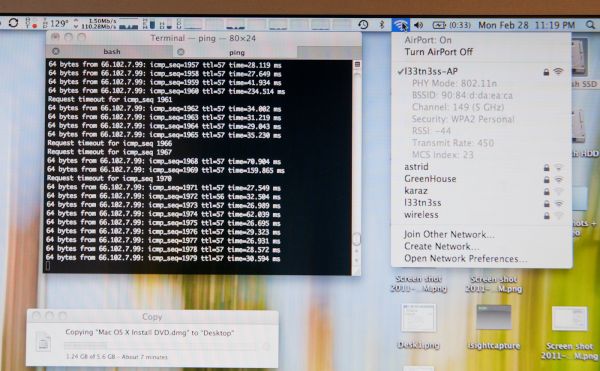 110.28 Megabits/s over WiFi. I later saw sustained 113 Megabits/s.
110.28 Megabits/s over WiFi. I later saw sustained 113 Megabits/s.
Subjectively, I found many more APs visible with the new MBP. I was able to cling onto my AP all the way out to the curb (just like smartphones) when connected on 2.4 GHz, something the old generation just couldn't do.
The only complaint I have about the new wireless chipset is that it seems to hunt around for what rate it wants negotiated. I saw a number of different MCS (modulation coding scheme) values with the 2011 MBP in the exact same place. Link rates from just below 300 Mbps all the way up to the expected 450. It seems to settle out at the expected 450 Mbps in the same room as the AP, it just takes a while, whereas other 2x2 stacks I've seen always lock onto 300 Mbps and stay there in the same room and position.










198 Comments
View All Comments
zhill - Friday, March 11, 2011 - link
Good article. I was thinking about your issue with the high cpu utilization, and could it simply be a reporting issue? Could the cpu performance counters or OSX be reporting QuickSync as part of the cpu rather than the GPU? This would certainly be strange and not accurate, but given that intel seems to list QuickSync and HD3000 separately, maybe the reporting stats aren't accurate. Presumably this would be an issue in both Windows and OSX, but at the driver level there could be differences. Just a thought.Have you, or anyone else, noticed heat issues with the MBP lid closed versus open? Aren't the vent ports along the back next to the hinge such that when open they can vent, but when closed airflow could be inhibited?
Anand Lal Shimpi - Friday, March 11, 2011 - link
I thought about that too, but there seems to be a genuine increase in thermal output from the CPU - higher than I'd expect from idle cores and the quick sync engine active.I haven't personally noticed any heat issues with the lid open vs. closed, seems to behave similarly (although now that you mention it I feel like open I do get temperatures a couple of degrees cooler than when it's closed - that could just be psychological though as the comparison is completely unscientific).
Take care,
Anand
Omid.M - Friday, March 11, 2011 - link
Anand,So do the 15-17" MBPs have hardware acceleration support for Flash? I didn't see that explicitly in the review; sorry if I missed it, but I tweeted you asking for this.
The last MBP update, Anand said the 13" he could highly recommend, but the 15" got way too hot under load.
This update, Anand said the 13" he could highly recommend, but the 15" gets way too hot under load.
Hmm. (not insinuating anything, Anand and crew)
I find that odd. But, maybe it's a good thing: I'm not comfortable buying an MBP until Apple build TRIM support for 3rd party SSDs into OSX. I would not want the Apple SSDs.
My early 2008 MBP is still running fine, although I'm tempted by the QC models. Maybe waiting until Ivy Bridge, in hopes of a cooler laptop, will be enough time to see if Apple brings TRIM for after-market SSDs.
I'm disappointed, but I guess this review saved me some money until next year.
Anand Lal Shimpi - Friday, March 11, 2011 - link
Sorry I think I missed your tweet! I measured around 40 - 60% CPU utilization of a single core when viewing a 1080p HD video in YouTube on the new 15-inch MBP (same CPU usage for both the iGPU and dGPU).The frame rate was perfectly smooth, but it's unclear to me how much lifting is being done by the GPU here.
Last year's 15 was pretty warm, but this year's model definitely didn't take a step back in that department - transistor count nearly doubled after all!
The move to 22nm should bring about marginal updates to architecture so I'm hoping for lower power consumption at similar performance levels.
Take care,
Anand
Omid.M - Friday, March 11, 2011 - link
Anand,You mentioned in the last MBP refresh/review that the 13" showed support for TRIM in OSX (evidenced in System Profiler, I believe).
You also said in this refresh/review that Apple supports TRIM for its own SSDs only.
To my knowledge, the last MBP generation had the SSD option for both 13" and 15-17" models, meaning the same SSD was offered across all models.
If TRIM is only supported for Apple SSDs, why did we see an evidence of TRIM in last year's 13" model but no evidence for the 15/17, assuming the same SSD was offered across the entire line and assuming the version of OSX shipped with the last models was the same across the line?
Was that due to different chipset drivers because the 13" had the Core 2 Duo/Nvidia combo, and the older 15/17 had Core i5/i7 (thus, newer chipset) ?
Does it make sense what I'm asking?
tno - Friday, March 11, 2011 - link
Apple ships different versions (small tweaks) of OSX with different laptops, and there is the key. If you recall, the field in System Profiler was populated indicating that at some level the chipset (Nvidia sourced) supported the instruction, but SSDs that supported the instruction did not.So you're correct, Nvidia chipset driver supported TRIM, but the OS did not implement the instruction. The Core i5/i7 integrated chipset driver had no support for TRIM.
http://www.anandtech.com/show/3762/apples-13inch-m...
name99 - Friday, March 11, 2011 - link
"I saw a number of different MCS (modulation coding scheme) values with the 2011 MBP in the exact same place. Link rates from just below 300 Mbps all the way up to the expected 450. It seems to settle out at the expected 450 Mbps in the same room as the AP, it just takes a while, whereas other 2x2 stacks I've seen always lock onto 300 Mbps and stay there in the same room and position."Is the state of the art any better than this?
The reason I ask is that the simple WiFi problem (1x1 antenna, what is the best modulation + puncturing I should use for this SINR?) is well understood.
But once MIMO enters the picture there are so many more options available --- for example: should we try to use all receive antennas for different streams, and run those three streams at "robust" modulation, or should we transmit a single "fragile" (64-QAM, 5/6) stream, and rely on receive diversity to be able to detect it without error? If we send a "fragile" stream, should we use the transmit antennas to perform beam shaping to target more power at the target?
As I understand it, optimal methods for handling the juggling between all the different types of diversity available in the MIMO space still do not really exist (if anyone has a reference stating otherwise, please provide it).
If this is the case, it would not surprise if, on either the base station end, the laptop end, or both, you have a huge amount of bouncing around between different possibilities (of course with 3x3:3 the space is larger than with 2x2:2 or 2x3:2) because what is being used to make the choices are simply heuristics, not engineered algorithms, and the heuristics are extremely sensitive to the slightest changes in the SINR covariance matrix).
Brian Klug - Friday, March 11, 2011 - link
I haven't really played around enough with other 3x3 WiFi stacks enough to say for certain. I agree with you that a lot of this is it making some decisions based on whether to prioritize connection robustness or throughput rate. At close ranges, it certainly selects MCS that gives most throughput, but I'm still shocked to not see more 450 Mbps when in the exact same room as the AP.Moving away, you'll quickly fall back to single stream rates (but obviously still get MIMO range extension). You're exactly right that everyone has their own heuristics for how to do this based on SINR. I still haven't figured out how to actually grab SINR out on here, all I can see for the moment is just RSSI. Completely agreed though.
-Brian
MrCromulent - Friday, March 11, 2011 - link
Once again a very detailed, comprehensive and yet easy to understand article!I'd like to inquire once more about the C300: In the initial test, the C300 was criticized for poor garbage collection. Now it's considered an option for Apple notebooks. Has the GC been improved by Marvell in the last few firmware updates?
Griswold - Friday, March 11, 2011 - link
Interesting revenue information right at the start. Apple went from a computer- to a music&player- to a phone company. :P